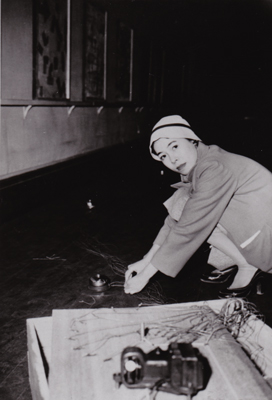
To the left: Atsuko Tanaka, Work, 1957 To the right: Atsuko Tanaka, Work, 1957 © Kanayama Akira and Tanaka Atsuko Association. Courtesy Ashiya City Museum of Art & History. In the middle: Atsuko Tanaka installing Work (Bell) at the 3rd Genbi Exhibition, Kyoto, 1955. Courtesy Kanayama Akira and Tanaka Atsuko Association
Biography Atsuko Tanaka
1932
Atsuko Tanaka is born on February 10th in Nishi-ku, Osaka.
1950
Tanaka enters the Art Institute of Osaka Municipal Museum of Art. Among her fellow students are Akira Kanayama and Kazuo Shiraga. By the second year at the institute, she moves away from her previous figurative style.
1953–1954
Through Kanayama, Tanaka meets the members of the Zero Society (Zero-kai), an artist collective founded 1952, and attends the group’s meetings.
1955
Members of the Zero Society, including Tanaka, Kanayama, and Saburo Murakami are invited to join ranks with the Osaka-based Gutai group, founded the previous year. Tanaka exhibits ”Work (Bell)” (1955) in the ”1st Gutai Art Exhibition” at Ohara Kaikan hall, Tokyo. When the work is later included in the ”3rd Genbi Exhibition” in the Kyoto Municipal Museum of Art, a daily newspaper introduces Tanaka under the headline: “Twenty Bells Take You by Surprise: A Young Lady’s Work Accepted to Genbi’s Exhibition Without Problem.”

1956
”Life” magazine sends reporters to Osaka for a photo-essay on Gutai. For the sake of the article the Gutai members stage a one-day outdoor exhibition. The article is never published. At the ”2nd Gutai Art Exhibition” that opens at Ohara Kaikan hall in Tokyo, Tanaka exhibits ”Denkifuku (Electric Dress)” (1956) for the first time. Consisting of around 200 coloured light bulbs, the work is both a sculpture and a dress to be used on stage.

1957
In May the group members organizes ”Gutai Art on the Stage” at Sankei Kaikan hall, Osaka. Tanaka participates with ”Stage Clothes” (1957), performed in front of ”Work (Red Dress)” (1956). The French art critic and curator Michel Tapié visits Ashiya and sees works by the Gutai members.
1958
During spring the group organizes the ”2nd Gutai Art on the Stage” in Osaka. In connection to exhibition Tanaka writes: “We always want a fresh sensibility. We are attracted to a simple, subtle, and intense sensibility.” The ”6th Gutai Art Exhibition” takes place at the Martha Jackson Gallery in New York, and later travels in the US.
1959
For a Gutai exhibition in Kyoto, Tanaka constructs a large, untitled spherical work.
1960
”The International Sky Festival” takes place on the roof of the Takashimaya department store in Osaka. The artists were invited to create drawings which were then enlarged and hung from advertising balloons creating an exhibition in the sky.

1963
The Gutai Pinacotheca hosts a solo exhibition of Tanaka’s work. On the recommendation of the American artist Sam Francis, Tanaka has her first solo presentation at the Minami Gallery in Tokyo. Francis also acquires a painting from the exhibition, which is later given the title ”Thanks Sam” (1963).
1964
”Thanks Sam” is included in the ”Guggenheim International Award” exhibition at the Solomon R. Guggenheim Museum, New York. At the ”6th Contemporary Art Exhibition of Japan” at the Tokyo Metropolitan Art Museum, Tanaka receives an excellence award. American artist Jasper Johns visits the exhibition and meet with the Gutai artists. Tanaka’s works are included in an exhibition at the Centro de Artes Visuales del Instituto Torcuato Di Tella in Buenos Aires.

1965
The exhibition ”The New Japanese Painting and Sculpture” opens at San Francisco Museum of Art, and travels extensively in the US during the following two years, including to the Museum of Modern Art (MoMA), New York. Tanaka is represented with two paintings, one of which is purchased by MoMA. After the summer, Tanaka and Kanayama decide to leave the Gutai group. The couple marries and moves to a house at the Myohoji Temple in Osaka.

1967–1968
In gallery exhibitions in Osaka, Tanaka shows paintings made on circular support, one of which rotates. In the fall of 1968, she performs ”Round on Sand” on Awaji Island. Photographer Hiroshi Fukuzawa documents the event in 16-mm film.
1987
The exhibition ”Japon des avantgardes, 1910–1970” opens at Centre Pompidou in Paris. Tanaka is represented with seven works, among them a reconstruction of ”Electric Dress”.
1993
”Work (Pink Cloth)” (1955/1993) and ”Stage Clothes” (1957/1993) are included in the ”45th International Art Exhibition” at La Biennale di Venezia, Venice.
1998
The landmark exhibition ”Out of Actions: Between Performance and the Object, 1949–1979” organised by the Museum of Contemporary Art, Los Angeles includes seventeen works by Atsuko Tanaka.
2001
Ashiya City Museum of Art and History organizes the first museum retrospective of Tanaka’s work. The exhibition ”Atsuko Tanaka: Search for an Unknown Aesthetic, 1954–2000” presents 145 works.
2005
After an extended period in the hospital, Atsuko Tanaka dies in December.


